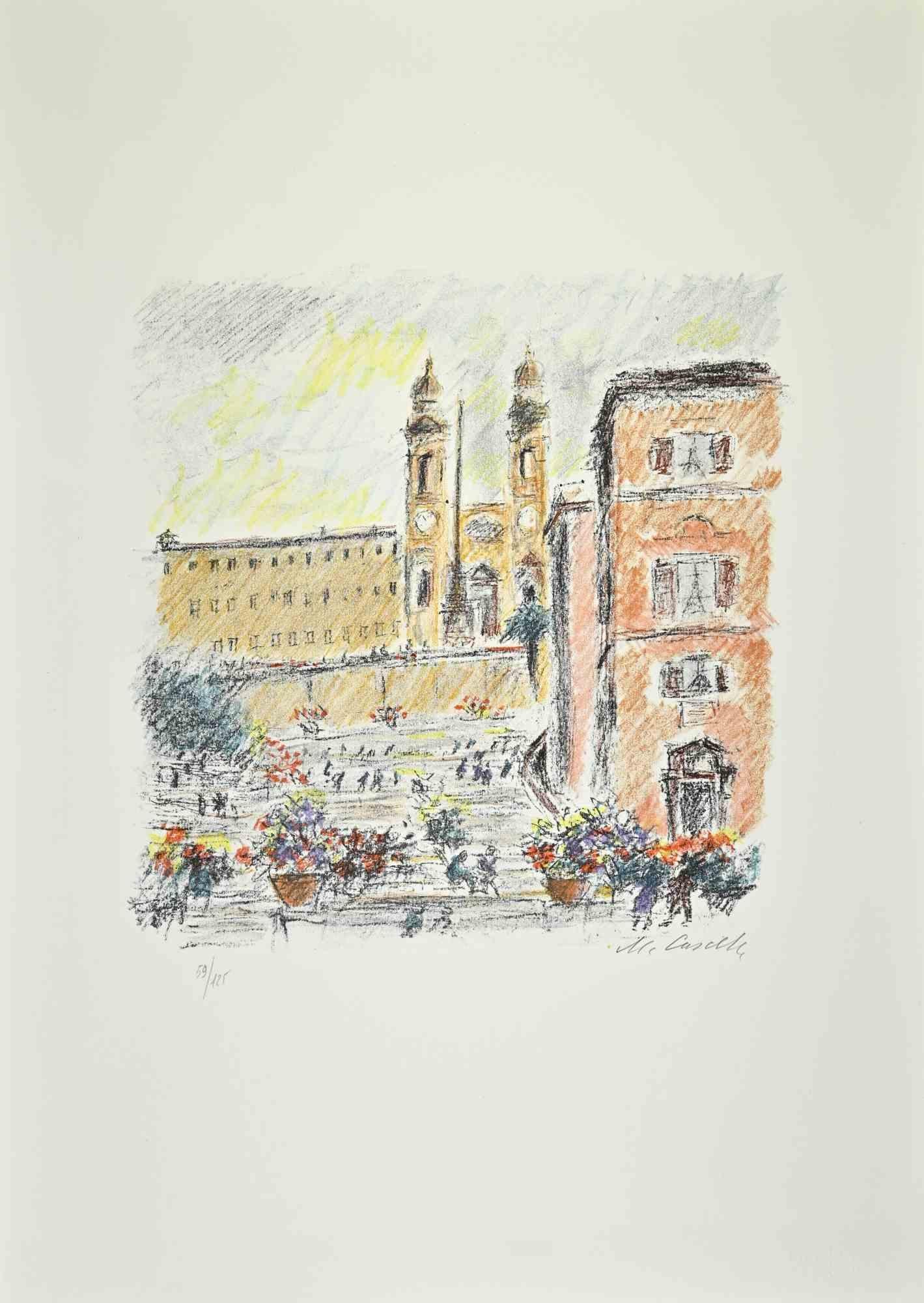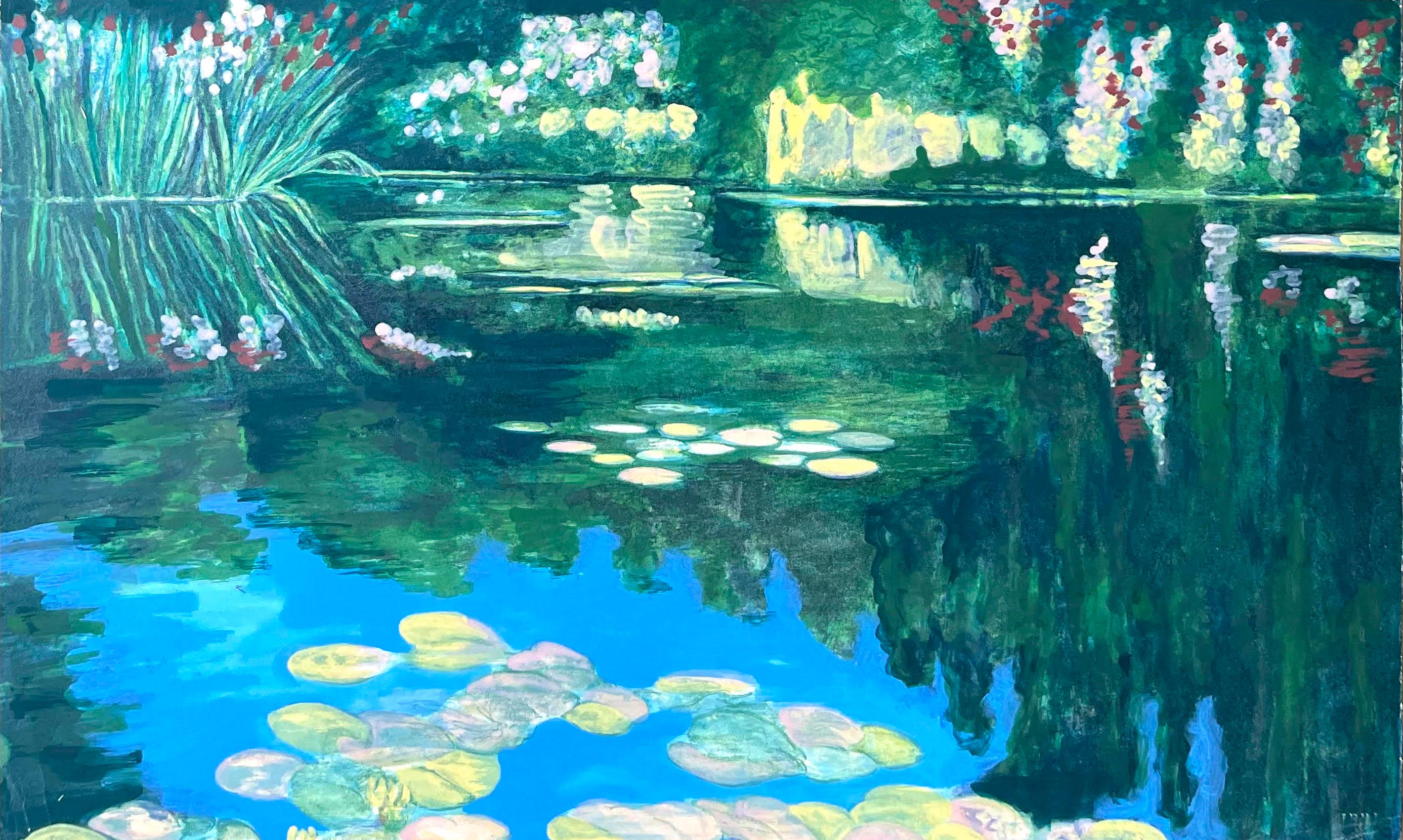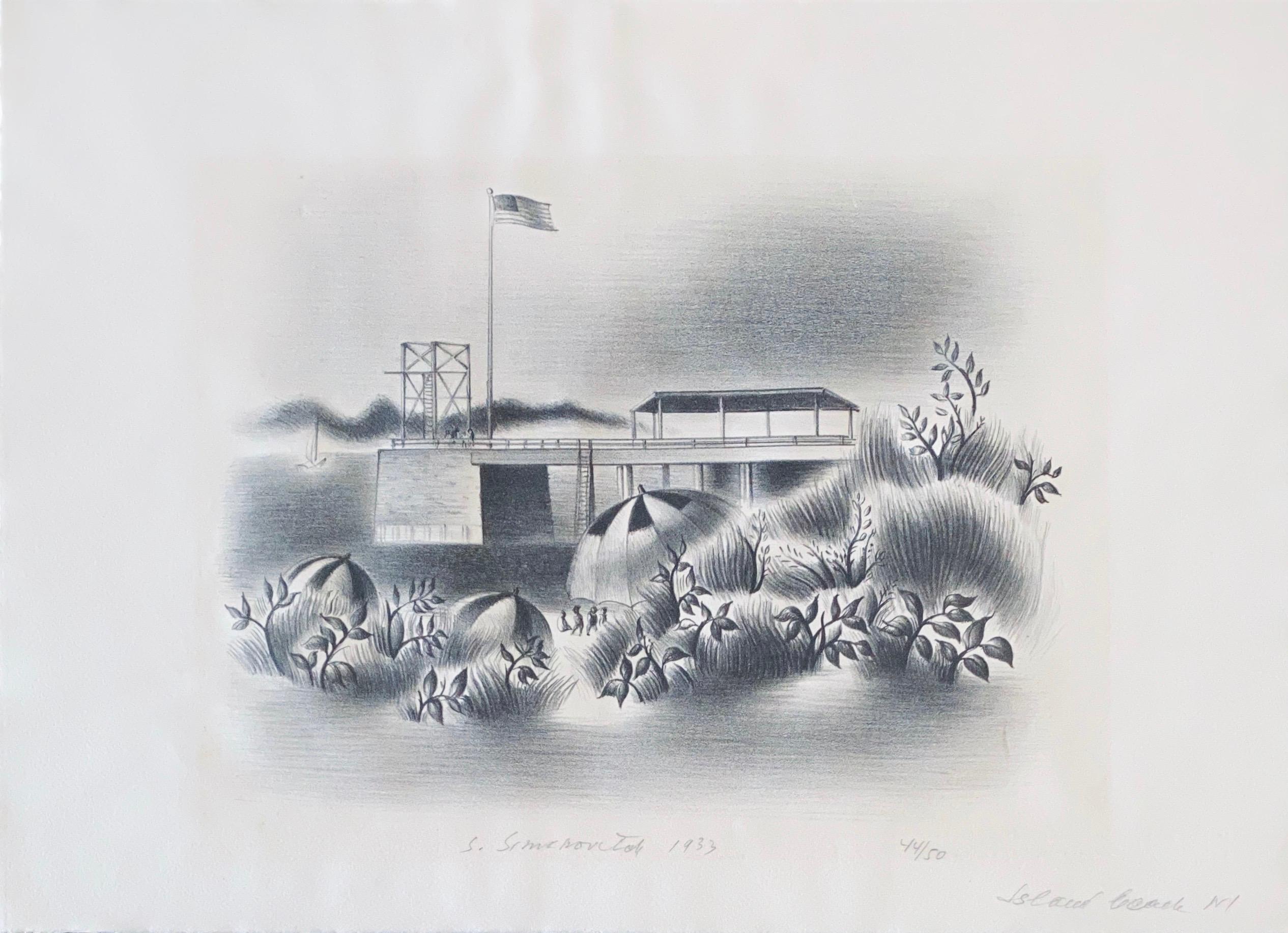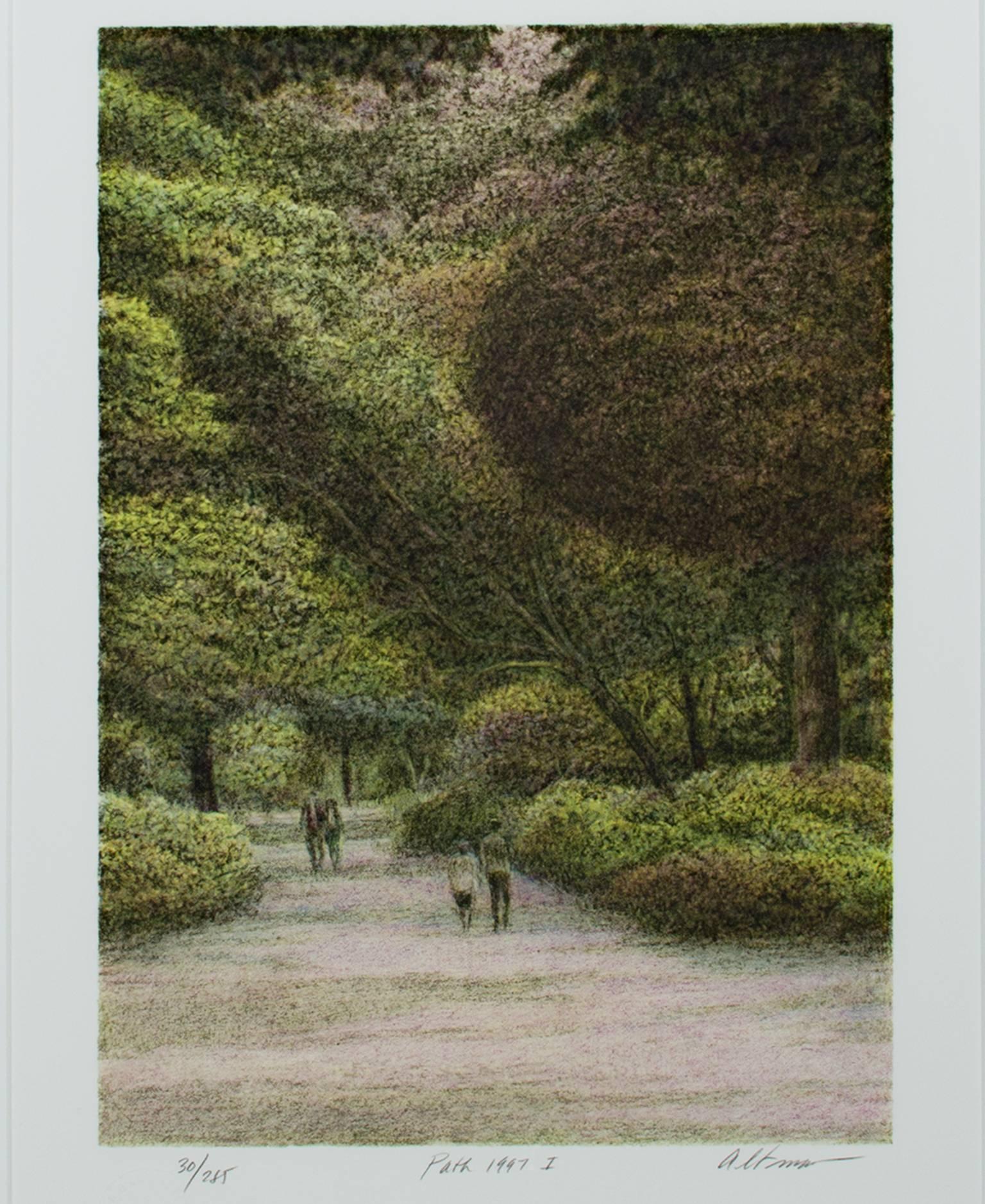Items Similar to Early 20th century color lithograph poster mountain field houses trees sky text
Want more images or videos?
Request additional images or videos from the seller
1 of 7
Paul KelschEarly 20th century color lithograph poster mountain field houses trees sky text1946
1946
About the Item
"Dauphine" is an offset lithograph of a pastoral landscape created by Paul Kelsch for the Societe Nationale des Chemis de fer Francais, the French National Railways.
24" x 39" paper
30 1/2" x 21 1/8" image
48" x 33" frame
Small hole in each corner, crease in paper and image upper left, small holes lower left.
The SNCF, the French National Rail system, commissioned multiple posters to advertise and celebrate the connected locations on their routes after the Second World War. "Dauphine", created by Paul Kelsch, showcases a small village at the foot of a mountain bathed in the light of a sunset. Kelsch's technique employed impasto brush strokes and bright colors to capture the beauty of the landscape. This scene is in stark contrast to the destruction that the war had wrought in this area during the 1944 invasion. Because of this, the set of posters would have reinforced the public's hope in a peaceful and beautiful France.
Printed in France for and by French National Railways; Publicite S.N.C.F.; No. 5 - 4 big; R.C. Seine No. 276.448B; Pub. Yves Alexandre-Paris
- Creator:Paul Kelsch
- Creation Year:1946
- Dimensions:Height: 48 in (121.92 cm)Width: 33 in (83.82 cm)
- Medium:
- Period:
- Condition:
- Gallery Location:Milwaukee, WI
- Reference Number:
About the Seller
4.9
Platinum Seller
These expertly vetted sellers are 1stDibs' most experienced sellers and are rated highest by our customers.
Established in 1966
1stDibs seller since 2017
393 sales on 1stDibs
Typical response time: 2 hours
- ShippingRetrieving quote...Ships From: Milwaukee, WI
- Return PolicyA return for this item may be initiated within 14 days of delivery.
More From This SellerView All
- Contemporary color lithograph landscape trees outdoor forest path scene signedBy Harold AltmanLocated in Milwaukee, WI"Path" is an original color lithograph by Harold Altman. The artist signed the piece lower right, wrote the title of the piece in the lower center, and wrote the edition number (30/2...Category
1990s Pointillist Landscape Prints
MaterialsLithograph
- "L'Entree en scene (The Emergence), " Color Lithograph after Rene MagritteBy René MagritteLocated in Milwaukee, WI"L'Entree en scene (The Emergence)" is a color lithograph after a 1961 original piece by Rene Magritte. A transparent bird flies over the ocean. The body of this bird shows through it a clean light sky with fluffy clouds. The view around the bird is instead the dark night, stars shine at the top of the scene. Clouds blow by and the waves are turbulent. Art: 12.13 x 9.75 in Frame: 22.75 x 20.38 in René-François-Ghislain Magritte was born November 21, 1898, in Lessines, Belgium and died on August 15, 1967 in Brussels. He is one of the most important surrealist artists. Through his art, Magritte creates humor and mystery with juxtapositions and shocking irregularities. Some of his hallmark motifs include the bourgeois “little man,” bowler hats, apples, hidden faces, and contradictory texts. René Magritte’s father was a tailor and his mother was a miller. Tragedy struck Magritte’s life when his mother committed suicide when he was only fourteen. Magritte and his two brothers were thereafter raised by their grandmother. Magritte studied at the Brussels Academy of Fine Arts from 1916 to 1918. After graduating he worked as a wallpaper designer and in advertisement. It was during this period that he married Georgette Berger, whom he had known since they were teenagers. In 1926, René Magritte signed a contract with the Brussels Art Gallery, which allowed him to quit his other jobs and focus completely on creating art. A year later he had his first solo show at the Galerie la Centaurie in Brussels. At this show Magritte exhibited what is today thought of as his first surrealist piece, The Lost Jockey, painted in 1926. In this work a jockey and his steed run across a theater stage, curtains parted on either side. Throughout the scene, there are trees with trunks shaped somewhat like chess pawns with musical scores running vertically up their sides and branches sticking out from all angles. Critics did not enjoy this style of art; it was new, different, and took critical thought to understand, but The Lost Jockey was only the first of many surrealist artworks Magritte would paint. Because of the bad press in Brussels, René and Georgette moved to Paris in 1927, with the hope that this center of avant-garde art would bring him success and recognition. In Paris, he was able to become friends with many other surrealists, including André Breton and Paul Éluard. They were able to learn from and inspire one another, pushing the Surrealist movement further forward. It was also in Paris that Magritte decided to add text to some of his pieces, which was one of the elements that made his artwork stand out. In 1929, he painted one of his most famous oil works: The Treachery of Images. This is the eye-catching piece centered on a pipe. Below the pipe is written “Ceci n’est pas un pipe,” which translates to “This is not a pipe.” This simple sentence upset many critics of the time, for of course it was a pipe. Magritte replied that it was not a pipe, but a representation of a pipe. One could not use this oil on canvas as a pipe, to fill it with tobacco and smoke it. Thus, it was not a pipe. In 1930, Magritte and Georgette moved back to Brussels. Though they would travel to his exhibitions elsewhere, their home going forward would always be in Brussels. Magritte had his first American exhibition at the Julien Levy Gallery in New York City in 1936 and his first show in England two years later in 1938 at The London Gallery...Category
2010s Surrealist Landscape Prints
MaterialsLithograph
- "La Bataille de l'Argonne (The Battle of Argonne), " Litho after Rene MagritteBy René MagritteLocated in Milwaukee, WI"La Bataille de l'Argonne (The Battle of Argonne)" is a color lithograph after the original 1959 painting by Rene Magritte. The landscape is shrouded by ...Category
2010s Surrealist Landscape Prints
MaterialsLithograph
- Sierra Madre - Lithographic PosterBy Carol SummersLocated in Milwaukee, WIThis is an offset lithograph poster signed by the artist Carol Summers. Based on his original woodcut that is of a much larger size.Category
1980s Landscape Prints
MaterialsLithograph
- "Le Retour (Return), " Color Lithograph after Painting by Rene MagritteBy René MagritteLocated in Milwaukee, WI"Le Retour (Return)" is a color lithograph after the original 1940 painting by Rene Magritte. A bird which is really just the sky in the day and clouds. A nest bellow the bird has th...Category
Early 2000s Surrealist Landscape Prints
MaterialsLithograph
- 'Winter Silhouettes, ' offset lithograph by Schomer LichtnerBy Schomer LichtnerLocated in Milwaukee, WI'Winter Silhouettes,' a small and delicate print, is an original offset lithograph by the Milwaukee artist Schomer Lichtner. The composition displays registers of foliage, emerging from the white of the paper as though emerging from the snow-covered ground. The artwork is thus plays with the materials of printmaking; the paper is both the support and the primary indication of the season. The subtle texture of the tooth of the paper also adds life to the image, giving the snow a wind-swept, creature trodden surface. The free forms of the grasses and leaves resemble the lyrical mid-century works of the French artist Henri Matisse, which combined with these material concerns demonstrate Lichter's modern sensibilities. 3.75 x 2.75 inches, image 5.5 x 4.5 inches, paper 10 x 8 inches frame Signed and dated in the stone, lower right Framed to conservation standards in a shadow-box style mounting, using 100 percent rag matting, museum glass, and housed in a cherry wood moulding Overall excellent condition; some toning to edges of paper; some minor abrasions to frame Milwaukee artist Schomer Lichtner was well known for his whimsical cows and ballerinas and abstract imagery. He and his late wife Ruth Grotenrath, both well-known Wisconsin artists, began their prolific careers as muralists for WPA projects, primarily post offices. Lichtner also painted murals for industry and private clients. Schomer was a printmaker and produced block prints, lithographs, and serigraph prints. His casein (paint made from dairy products) and acrylic paintings are of the rural Wisconsin landscape and farm animals. He became interested in cows when he and Ruth spent summers near Holy Hill in Washington County. According to David Gordon, director of the Milwaukee Art Museum, Schomer Lichtner had a tremendous joie de vivre and expressed it in his art. Schomer Lichtner was nationally known for his whimsical paintings and sculptures of black- and white-patterned Holstein cows and elegant ballerina dancers. Lichtner also painted all sorts of combinations of beautiful women, flowers and country landscapes. James Auer, former Milwaukee Journal Sentinel art critic, said that his art eventually "exploded into expressionistic design elements with bold, flat areas of color and high energy that anticipated Pop Art." Auer went on to describe Lichtner’s work as full of "wit, vigor and virtuosity." As early as 1930, Lichtner’s work was shown at the prestigious Carnegie International Exhibition in New York and at museums throughout the Midwest. As a student, he was a protégé of another icon of 20th century American art, Gustave Moeller. Lichtner and his wife, Ruth Grotenrath (1912-1988), are celebrated as Milwaukee’s first couple of painting and are regarded as major Wisconsin artists. Lichtner’s impressive production, perseverance, longevity, and positive approach to his life and art made him and his work distinctive and much loved by his many admirers. His work is currently represented in collections at the Milwaukee Art Museum, the John Michael Kohler Art Center, the West Bend Museum, and in the collections of many individuals. Books on the lives and art work of both Lichtner and Grotenrath are in progress and it is anticipated that they will be published next year. Schomer Lichtner passed away on May 9, 2006 at the age of 101. He continued to amaze and create with his whimsical paintings of ballerinas...Category
1960s American Modern Landscape Prints
MaterialsBlack and White, Lithograph
You May Also Like
- Sketches of Auden: black drawing based on Auden poetry and Yorkshire landscapeBy Henry MooreLocated in New York, NYThis black and white portrait drawing is one of a series of 18 lithographs drawn by the artist for the Auden Poems/Moore Lithographs 1974 book and portfolio. This work is from an edition of 25 printed on vellum aside from the portfolio (edition of 75) and the book. Signed by the artist and numbered 8/25 lower right in pencil. This print features a pair of sketches...Category
Late 20th Century Modern Abstract Prints
MaterialsLithograph
- Trinità dei Monti - Lithograph by Michele Cascella - 1979Located in Roma, ITPiazza di Spagna is an artwork realized in 1979, by the Italian Artist Michele Cascella. Colored lithograph on paper of the Portfolio "Landscape", 1979, with six original lithograph and the poems of Franco Simongini titled "Twenty Landscapes 1953-1960" Hand-signed on the lower right in pencil and numbered edition of 59/125 ex. Lower right blind stamp of the Printer Graphis Art, Livorno The state of preservation of the artwork is very good. Michele Cascella (Ortona, 7 September 1892 - Milan, 31 August 1989) was an Italian twilight painter and landscape painter. Over the course of his long artistic life which spanned almost eight decades of intense activity, Cascella has been able to maintain a unique, unmistakable style which is practically immune to the contamination of the pictorial currents and avant-gardes of the twentieth century. His works, including canvases, panels, pastels and drawings, are exhibited in numerous Italian and international museums, including the Victoria and Albert Museum[1] in London, the Galerie nationale du Jeu de Paume in Paris, the National Museum of History and Art in Luxembourg, the Musée d'Art Moderne in Brussels and the De Saisset Art Gallery of the University of Santa Clara in...Category
1970s Contemporary Landscape Prints
MaterialsLithograph
- Lily Pond at Giverny, gorgeous signed lithograph with hand coloring unique var.Located in New York, NYDiane Burko Lily Pond at Giverny, 1990 Hand colored monoprint (lithograph with hand coloring) Hand signed and numbered 8/95 by the artist and bears publish...Category
1990s Contemporary Landscape Prints
MaterialsMonoprint, Mixed Media, Acrylic, Graphite, Lithograph
- Simka Simkhovitch WPA Artist Lithograph Island Beach 1933 American ModernistBy Simka SimkhovitchLocated in Surfside, FLSimka Simkhovitch (Russian/American 1893 - 1949) signed lithograph. Pencil signed and dated "S. Simkhovitch 1933" lower center. Title "Island Beach," in pencil lower left of sheet. Numbered "44/50" in pencil lower right. (it is either Island Beach Wisconsin or New Jersey) Simka Simkhovitch (Симха Файбусович Симхович) (aka Simka Faibusovich Simkhovich) (Novozybkov, Russia May 21, 1885 O.S./June 2, 1885 N.S.—Greenwich, Connecticut February 25, 1949) was a Ukrainian-Russian Jewish artist and immigrant to the United States. He painted theater scenery in his early career and then had several showings in galleries in New York City. Winning Works Progress Administration (WPA) commissions in the 1930s, he completed murals for the post offices in Jackson, Mississippi and Beaufort, North Carolina. His works are in the permanent collections of the Dallas Museum of Art, the National Museum of American Art and the Whitney Museum of American Art. Born outside Kyiv (Petrograd Ukraine) into a Jewish family who owned a small department store. During a severe case of measles when he was seven, Simcha Simchovitch sketched the views outside his window and decided to become an artist, over his father's objections. Beginning in 1905, he studied at the Grekov Odessa Art School and upon completion of his studies in 1911 received a recommendation to be admitted to the Imperial Academy of Arts. Though he enrolled to begin classes in architecture, painting, and sculpture at the Imperial Academy, he was dropped from the school roster in December because of the quota on the number of Jewish students and drafted into the army. Simchovitch served as a private in the 175th Infantry Regiment Baturyn [ru] until his demobilization in 1912. Re-enrolling in the Imperial Academy, he audited classes. Simka Simkhovitch exhibited paintings and sculptures in 1918 as part of an exhibition of Jewish artists and in 1919 placed 1st in the competition "The Great Russian Revolution" with a painting called "Russian Revolution" which was hung in the State Museum of Revolution. In 1922, Simkha Simkhovitch exhibited at the International Book Fair in Florence (Italian: Fiera Internazionale del Libro di Firenze). In 1924, Simkhovitch came to the United States to make illustrations for Soviet textbooks and decided to immigrate instead. Initially he supported himself by doing commercial art and a few portrait commissions. In 1927, he was hired to paint a screen for a scene in the play "The Command to Love" by Fritz Gottwald and Rudolph Lothar which was playing at the Longacre Theatre on Broadway. Art dealers began clamoring for the screen and Simkhovitch began a career as a screen painter for the theater. Catching the attention of the screenwriter, Ernest Pascal, he worked as an illustrator for Pascal, who then introduced him to gallery owner, Marie Sterner. Simkhovitch's works appeared at the Marie Sterner Gallery beginning with a 1927 exhibit and were repeated the following year. Simkhovitch had an exhibit in 1929 at Sterner's on circus paintings. In 1931, he held a showing of works at the Helen Hackett Gallery, in New York City and later that same year he was one of the featured artists of a special exhibit in San Francisco at the California Palace of the Legion of Honor in Lincoln Park. The exhibit was coordinated by Marie Sterner and included four watercolors, including one titled "Nudes". He is of the generation of Russian Soviet artists such as Isaac Pailes, Serge Charchoune, Marc Chagall, Chana Orloff, Isaac Ilyich Levitan, and Ossip Zadkine. In 1936, Simkhovitch was selected to complete the mural for the WPA Post office project in Jackson, Mississippi. The mural was hung in the post office and courthouse in 1938 depicted a plantation theme. Painted on the wall behind the judge’s bench, “Pursuits of Life in Mississippi”, a depiction of black workers engaged in manual labor amid scenes of white professionals and socialites, was eventually covered over in later years during renovations due to its stereotypical African American imagery. The following year, his painting "Holiday" won praise at an exhibition in Lincoln, Nebraska. In 1940, Simkhovitch's second WPA post office project was completed when four murals, "The Cape Lookout Lighthouse and the Orville W. Mail Boat", "The Wreck of the Crissie Wright", "Sand Ponies" and "Canada Geese" were installed in Beaufort, North Carolina. The works were commissioned in 1938 and did not generate the controversy that the Jackson mural had. The main mural is "The Wreck of the Crissie Wright" and depicts a shipwreck which had occurred in Beaufort in 1866. "The Cape Lookout Lighthouse and the Orville W. Mail Boat" depicted the lighthouse built in 1859 and the mail boat that was running mail during the time which Simkhovitch was there. The boat ran mail for the area until 1957. "Sand Ponies" shows the wild horses common to the North Carolina barrier islands and "Canada Geese" showed the importance of hunting and fishing in the area. All four murals were restored in the 1990s by Elisabeth Speight, daughter of two other WPA muralists, Francis Speight...Category
1930s American Modern Landscape Prints
MaterialsLithograph
- Alps - Lithography on Paper by A. Lauro - 20th CenturyLocated in Roma, ITAlps is an original lithography artwork on paper realized by A. Lauro in the XX century. The State of preservation is very good. Included a white Passepartout: 34 x 49 cm. The ar...Category
20th Century Modern Figurative Prints
MaterialsLithograph
- Marine Noire - Lithograph After Georges Braque - 1956Located in Roma, IT"Marine Noire" is a lithograph after the work of Georges Braque in 1956. The print is hand signed and numbered. This is an edition of 400 prints. Bibliography: D. Vallier, Braque. L'oeuvre gravé, Flammarion, Paris 1982, n. 1044, p. 296. Good conditions except for very light foxings and little folds on the corner. Georges Braque (1882-1963) was a French Fauve painter who began to rethink his own painting style after admiring Picasso’s Les Demoiselles...Category
1950s Post-Impressionist Landscape Prints
MaterialsLithograph





